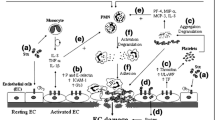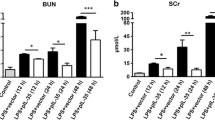Abstract
Induction of experimental hemolytic uremic syndrome (HUS) by simply administering Shiga-like toxin (Stx) to rodents has not yet been successful. Attention has been paid to the role of lipopolysaccharide (LPS) in the pathogenesis of HUS. In this study, we showed successful induction of an experimental HUS in LPS responder mice by administering Stx together with LPS. Intraperitoneal administration of 200 ng of Stx 2 for 2 days, followed by 250 μg of LPS on the 2nd day of Stx administration, caused a significant decrease of thrombocytes and deterioration of renal function, with proteinuria and hematuria. Electron microscopy revealed alterations of glomerular endothelial cells. Administration of Stx alone or LPS alone caused neither hematological nor histopathological changes, as were observed with Stx and LPS co-administration. Interestingly, when LPS was administered before Stx, no hematological and histological changes were observed. The results showed that LPS was essential for the induction of HUS, but LPS pretreatment might protect against Stx toxicity. The order of LPS and Stx administration is important for the induction of experimental HUS.






Similar content being viewed by others
References
Karmali MA, Petric M, Lim C, Fleming DC, Arbus GS, Lior H (1985) The association between idiopathic hemolytic uremic syndrome and infection by verotoxin-producing Escherichia coli. J Infect Dis 151:775–782
Taylor FB Jr, Tesh VL, DeBault L, Li A, Chang AC, Kosanke SD, Pysher TJ, Siegler RL (1999) Characterization of the baboon responses to Shiga-like toxin: descriptive study of a new primate model of toxic responses to Stx-1. Am J Pathol 154:1285–1299
Barrett TJ, Potter ME, Wachsmuth IK (1989) Bacterial endotoxin both enhances and inhibits the toxicity of Shiga-like toxin 2 in rabbits and mice. Infect Immun 57:3434–3437
Bertani T, Abbate M, Zoja C, Corna D, Remuzzi G (1989) Sequence of glomerular changes in experimental endotoxemia: a possible model of hemolytic uremic syndrome. Nephron 53:330–337
Karpman D, Connell H, Svensson M, Scheutz F, Alm P, Svanborg C (1997) The role of lipopolysaccharide and Shiga-like toxin in a mouse model of Escherichia coli O157:H7 infection. J Infect Dis 175:611–620
Zhang H, Peterson JW, Niesel DW, Klimpel GR (1997) Bacterial lipoprotein and lipopolysaccharide act synergistically to induce lethal shock and proinflammatory cytokine production. J Immunol 159:4868–4878
Tesh VL, Burris JA, Owens JW, Gordon VM, Wadolkowski EA, O’Brien AD, Samuel JE (1993) Comparison of the relative toxicities of Shiga-like toxins type 1 and type 2 for mice. Infect Immun 61:3392–3402
Palermo M, Alves-Rosa F, Rubel C, Fernandez GC, Fernandez-Alonso G, Alberto F, Rivas M, Isturiz M (2000) Pretreatment of mice with lipopolysaccharide (LPS) or IL-1beta exerts dose-dependent opposite effects on Shiga toxin-2 lethality. Clin Exp Immunol 119:77–83
Newburg DS, Chaturvedi P, Lopez L, Devoto S, Fayad A, Cleary TG (1993) Susceptibility to hemolytic-uremic syndrome relates to erythrocyte glycosphingolipid patterns. J Infect Dis 168:476–479
Loo DM te, Monnens LA, Velden TJ van der, Vermeer MA, Preyers F, Demacker PN, Heuvel LP van den, Hinsbergh VW van (2000) Binding and transfer of verocytotoxin by polymorphonuclear leukocytes in hemolytic uremic syndrome. Blood 95:3396–3402
Setten PA van, Monnens LAH, Verstraten RGG, Heuvel LPWJ van den, Hinsbergh VWM van (1996) Effects of verocytotoxin-1 on nonadherent human monocytes: binding characteristics, protein synthesis, and induction of cytokine release. Blood 88:174–183
Kaplan BS, Cleary TG, Obrig TG (1990) Recent advances in understanding the pathogenesis of the hemolytic uremic syndromes. Pediatr Nephrol 4:276–283
Turi S, Nemeth I, Vargha I, Matkovics B (1994) Oxidative damage of red blood cells in haemolytic uraemic syndrome. Pediatr Nephrol 8:26–29
Acknowledgements
Stx2 was graciously provided by Dr. Kohsaka (Department of Pediatric Nephrology, National Children’s Hospital, Tokyo, Japan). The authors thank Mr. Hoshino and Mr. Takahashi for their laboratory assistance. This work was supported by a grant for “EHEC associated hemolytic uremic syndrome” from the Ministry of Health and Welfare project for “A newly risen and revived infectious disease”.
Author information
Authors and Affiliations
Corresponding author
Rights and permissions
About this article
Cite this article
Ikeda, M., Ito, S. & Honda, M. Hemolytic uremic syndrome induced by lipopolysaccharide and Shiga-like toxin. Pediatr Nephrol 19, 485–489 (2004). https://doi.org/10.1007/s00467-003-1395-7
Received:
Revised:
Accepted:
Published:
Issue Date:
DOI: https://doi.org/10.1007/s00467-003-1395-7




